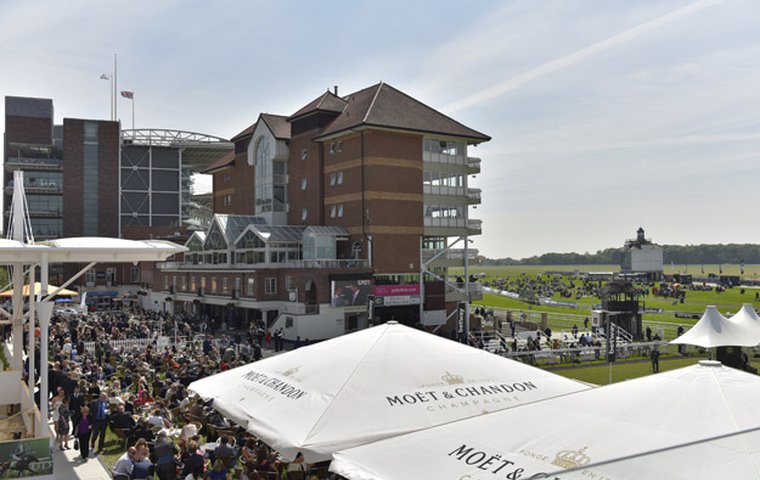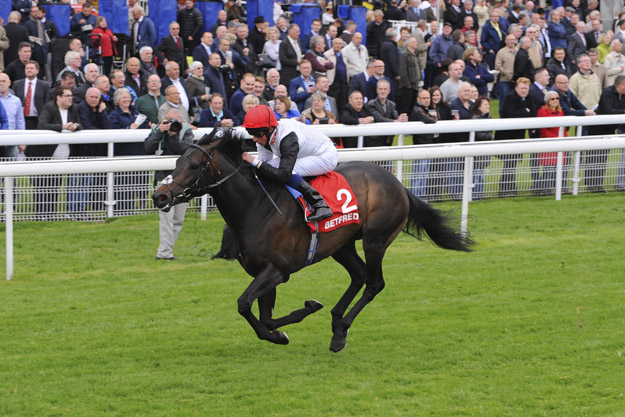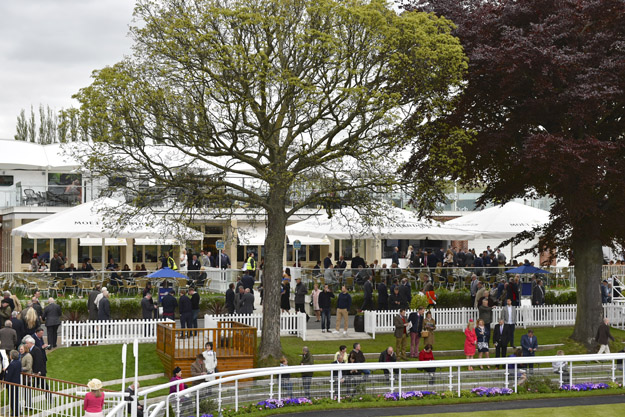
York Racecourse is riding the crest of a wave. The best horses are running there, owners and trainers love the place, and customer satisfaction generally is soaring. But there is no sign of complacency. The finishing touches are being applied to a major redevelopment, which will be complete in time for the track’s biggest fixture, the Ebor Festival (Aug. 19-22), and the management is always on the lookout for ways of enhancing the York experience, as Chief Executive William Derby explained in this question-and-answer interview.
You must be particularly delighted with the 2015 runnings of York’s two big classic trials at the May meeting after Golden Horn and Jack Hobbs, first and second in the G2 Betfred Dante Stakes, went on to fill the same two spots in the Investec Derby at Epsom, and Star Of Seville, who prevailed in the G3 Tattersalls Musidora Stakes, later took the Prix de Diane Longines (French Oaks) at Chantilly. Do you feel this underlines the races’ status as the premier trials for the big European middle-distance classics?
“The Dante Festival falls at a fascinating time in the British flat season. Normally the weather and conditions are on the upgrade as spring comes alive, and the horses themselves are starting to focus on the season ahead.
“Many people have said that for them it is the meeting when the European flat season starts to spring into life. Our aim is to set the prize money, facilities, and experience for connections to run their colts and fillies with exciting potential with us, and hope that the meeting unearths the stars of the classic generation.
“Ten horses have completed the Betfred Dante-Epsom Derby double from St Paddy in 1960 to Golden Horn this year, with last year’s winner, The Grey Gatsby, taking the French Derby. Workforce in 2010 is the only colt ever beaten in a Dante to then win the Derby - and the horse that beat him, Cape Blanco, went on to win the Irish Derby.
“Tattersalls have been fantastic supporters of the Musidora, and partnered with us to make it a six-figure contest this year. We have to go back to Reams of Verse in 1997 for the last of the six fillies to do the Musidora-Epsom Oaks double, but the bad luck in running at Epsom of both Star of Seville and The Fugue suggest that the form may be better than the results.
“If you consider the likes of Islington and Sariska bouncing out of York to wider success, then the status of both races is underlined.
“We are delighted by the results from this year’s Dante Festival, where many horses have gone on to further success and to frank the form at Epsom, the Curragh, Chantilly, and Royal Ascot. We very much hope some of them with return for our flagship meeting in August, the Ebor Festival.”
What do you think it is about the Musidora and particularly the Dante (which has produced five Epsom Derby winners, three Irish Derby winners, and a French Derby winner in the last 12 years) that gives them the edge over other trials?
“Hopefully, the strong performance of the York races demonstrates that our ongoing investment in prize money and in facilities for both owners, horses, and racing professionals, pays a dividend.
“In terms of the configuration of the racecourse, the flat, left-handed track with a long, wide home straight is very fair. We completed a large track project in 2009 with new drainage, irrigation, and associated works, which have helped us further improve the racing surface, aided by a fantastic grounds team and head groundsman, who won the Institute of Groundsmanship top award across all professional sports in Britain.
“Hopefully, the welcome and atmosphere on course contribute to an environment where the connections of top horses want to compete at York. I am encouraged when owners and trainers say they love having runners at York. I am a big believer in success building success so hope the profile and status of the races will continue on an upward trajectory and help continue to attract the best horses to York.”

York Racecourse is renowned not only for the quality of its racing but also for the quality of its facilities - it has just won a local tourism award and was this year named Britain’s Northern Racecourse of the Year for the 25th season in succession. Yet you are not resting on your laurels. An ambitious new £10 million development at the northern end of the course is nearing completion. What changes are being made in this project?
“Over the past 20 years we have invested over £50 million in the stands, stables, track, and wider infrastructure at York. In all these developments, we have tried to make York a great place to enjoy racing – either as a racegoer, punter, owner, or racing professional. Being close to the historic city of York and set in beautiful parkland called the Knavesmire makes for both great viewing and a tremendous atmosphere on race days.
“The Northern End Development has been a £10 million, two-year investment to reconfigure the facilities for horses, jockeys, and racegoers in the area around the parade ring, aimed at improving the experience for all and to help York to continue to be a leading racecourse in the world.
“The key element was to relocate the pre-parade ring to give horses, connections, and racegoers more space and a better layout. Crucial to achieving this was convincing our landlord, the City of York Council, to let us incorporate some extra land from the Knavesmire, which is public land.
“This has allowed us to build a bigger and flatter pre-parade ring with saddling boxes, washdown and equine welfare facilities; a new, modern weighing room for jockeys [which was opened by the Duke of York in May] and is in use for the first time this season.
“The other elements of the scheme, which are being finished ahead of Ebor, include improved facilities for owners and racegoers with the new Parade Ring Restaurant, owners’ entrance, and new champagne bars and lawns.
“We are delighted with how the project has transformed this area. We wanted to deliver modern, high-quality, and first-class facilities but for these to be appropriate and in keeping with the setting and context of York. It was a tight programme and it is never straightforward building the main structures in the winter, but the design, construction and our own racecourse team worked really hard to deliver the facilities to be in use for the Dante Festival, with the completion of the project on course for Ebor 2015.
“The reaction from jockeys, owners, and racegoers has been overwhelmingly positive. It transforms the layout of this area of the racecourse and improves viewing, the facilities, and the landscape. One of the most pleasing things for me is the reaction of the horses – they seem so relaxed and settled in the pre-parade ring, which is one of the key objectives we wanted to achieve.
“We are planning to formally open the Northern End Development with the official unveiling of the Sir Henry Cecil Gates by the new owners’ entrance and a new, adjacent statue of Frankel.
“Aside from the racing, there are lots of other elements to the meeting, including the Ebor Fashion Lawn, music both during and after racing, and some fabulous menus for our restaurants.”
How will the development impact the experience for racegoers and connections, and why was it felt necessary to enhance already acclaimed facilities?
“The development allows more space and better configuration for horses, an improved experience for owners, trainers, and jockeys, and improved viewing and facilities for racegoers of horses and riders as they prepare for their race.
"The changing nature of ownership - with more syndicates and ownership racing clubs - means more and more people want to be close to their horse and experience the thrill of ownership so the new facilities, including an iconic building for winning connections to celebrate their win, have been created.
“Racegoers can see into the weighing room as jockeys weigh in and out before and after the race. We have created light and airy facilities for jockeys, with one-way windows allowing them to see out as they prepare for the racing.
“The development has allowed us to better preserve and present one of the original stands at York, built in 1754 by John Carr and believed to be the oldest grandstand on a sporting venue anywhere in the world.
“As with all stadia and racecourses, there is a continued need to keep investing in facilities as expectations and competition for spectators and the stars of the sport continually rise.”

£10 million is a massive investment, especially when there are just 17 days’ racing each season to help recoup it. How do you assess the success of such an upgrade, and how do you make sure it does indeed pay for itself ultimately?
“In the modern world, it would be phrased in terms of building our brand equity and profile, but I prefer to think of it as improving the experience of coming racing at York. Being a popular venue with connections and racegoers creates a virtuous circle, with high-quality runners attracting the crowds and media interest.
“The nature of racing in Britain, where a smaller proportion of the sport is funded by gaming than internationally, means we have to work very hard both on race days and on our non-raceday business to offer a great experience and value for money to generate a return on investment. While racing will always be our core business, we stage over 700 events outside racing each year from conferences, to exhibitions, trade fairs, weddings, etc.
“Racecourse key performance indicators are many and varied, from the quality of the action on the track and the ratings of the races; the commercial, operational, and customer experience on the race day; and the rather more intangible atmosphere and legacy of great racing and long lasting memories for fans and connections.”
Are there other parts of the course that you will consider for development once the Northern End project is finished?
“We never struggle to find things to spend money on – it is getting the revenue in that is the challenge!
“We will keep investing to further improve the facilities, experience and prize money at York and aim to keep attracting the best horses and jockeys to race at York and racegoers to watch them.”
The International Federation of Horseracing Authorities has ranked York’s flagship race, the £850,000 Juddmonte International Stakes on the first day of the Ebor Festival, the No. 1 race in the world - ahead of the Qatar Prix de l’Arc de Triomphe, the Qipco British Champion Stakes, and the Breeders’ Cup Classic [the rankings are based on the strength of the fields over the last three years, during which time the International was won by Frankel, Declaration Of War, and Australia]. The race has an illustrious history as it is, but do you think it has become even more prominent recently?
“The Group 1 Juddmonte International is our flagship race and the richest race we stage. We are honoured and delighted for it to have been ranked the top race in the world as a reflection of the fantastic past performances on the track.
“Since the first race between Roberto and Brigadier Gerard in 1972, this 10 furlong and 88 yard event in mid-August has established itself as a key contest of the European summer flat season. The distance, time of year, and conditions of the race have attracted great contests, with 3-year-olds taking on the older horses, fillies taking on the colts, and horses specialised at various distances, taking each other on.
“Since 1989, the race has had the unstinting support of Juddmonte Farms, who have helped us build and grow the race in terms of prize fund and international profile.
“Prince Khalid finally won the race in 2011 with Twice Over and then followed up with the mighty Frankel in 2012. We hope that the success of the race in recent years, with winners like Sea the Stars, Authorized, and Giant’s Causeway, demonstrate it as a race the world’s elite horses want to target as part of their glittering race careers.”
With the success of the Dante, the Musidora, and the International, not to mention the other the G1 contests (the Darley Yorkshire Oaks and the Coolmore Nunthorpe Stakes, both run during the Ebor Festival), York certainly appears to be on the crest of a wave. There are many other prestigious races on the York calendar, of course, and they too have been flourishing. Are there strong cases for upgrading some of them?
“We are certainly ambitious to continue to improve and build our race programme and, in the last decade, have doubled our prize money and achieved 12 upgrades to our black-type race programme. Much like defending titles in other sports, it only gets more competitive at the top end of the Pattern. To meet the strict criteria for race upgrades, you need a consistently strong first four as well as a high-class winner, so these things don’t come easily, nor quickly.
“We do think that there is a growing case for our juvenile contests, with the Lowther, Gimcrack, and Acomb all producing tremendous winners recently and, especially in the case of the Lowther for juvenile fillies, we feel there is a compelling need for a summer Group 1 for juvenile fillies in Europe.
“We will be working hard to continue to attract the best horses to compete in these races and persuade the powers that be of their merits.”

